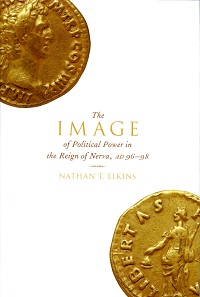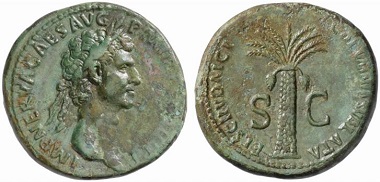Written by Ursula Kampmann
Translated by Leonie Schulze
September 20, 2018 – It really is common knowledge that images on coins are essential to our understanding of Roman policies. But nevertheless, they are often underestimated or misunderstood in terms of their significance. Reports by Roman historians – which were very often written much later – mask our unbiased analysis of the numismatic material which, in combination with inscriptions, constitutes arguably the most important contemporary source regarding the political plans and self-perception of an emperor. Just which decisive new insights can be taken from these coins is presented by author Nathan T. Elkins using the example of emperor Nerva, who is often treated as a mere intermezzo between the Flavian dynasty and the Five Good Emperors. The 65-year-old did in fact have his own agenda when he took over the throne and said agenda is reflected in his coinage.
Nathan T. Elkins, The Image of Political Power in the Reign of Nerva, AD 96-98. Oxford University Press 2017. 224 pp. and 91 images. Linen. 16 x 24 cm. ISBN: 9780190648039. 85 $. This work can also be ordered as an ebook.
Elkins takes this coinage seriously, approaches it with a new reading, but does not fall short of mentioning what his predecessors have already said about it. And he puts it in a bigger context. This book – and the material accordingly – is divided up into three big chapters:
- Nerva as supreme commander of the Roman military
- Nerva and his relation to the senate, the people of Rome, and Italy
- Nerva and the Roman Empire
These titles are self-explanatory. And the chapters offer an abundance of new interpretations of known coin images.
Nerva. Sestertius. FISCI IVDAICI – CALVMNIA SVBLATA / S-C date palm. RIC 82. From Numismatik Lanz auction 123 (2005), no. 542.
Let’s take the arguably most well-known coins of Nerva as an example: the date palm with the inscription „FISCI IVDAICI CALVMNIA SVBLATA“. The author explains this coin as being an echo of the end of a particularly unpopular legal practice: Roman citizens had to submit to embarrassing interrogations based on random allegations. These interrogations were supposed to determine whether they professed the Jewish religion and thus had to pay a temple tax. Even high society was involved in this! Sueton tells us that during one trial, a 90-year-old had to lift his toga in public to prove that he wasn’t circumcised.
If you keep these events in mind and you know that “calumnia” is a legal term denoting wrong accusations, then it becomes obvious, as Elkins explains, that Nerva’s coin did not refer to the end of the tax but merely to the fact that wrong accusations regarding the ficus iudaicus would no longer occur under his reign.
Therefore, Elkin’s book is more than an analysis of numismatic material from the time of Nerva’s reign. It is an answer of the question: what do I need to know to be able to put a coin image in its correct context.
And it is a study that also includes hoard evidence. How are the different coin motifs and their various target groups distributed within the different parts of the empire? Does the distribution correlate with the postulated target groups? The author purposely doesn’t use coins taken from public or private collections to determine the proportions of the minted types. He assumes that every coin collection is also a positive selection of material: the collector (or the curator) focuses on fascinating, historically interesting, but rather rare pieces and thus falsifies the proportions. Whatever one didn’t need was even melted in former times…
His task is made more difficult by the varying publication of surviving coins. Italy has a notably vast amount of unpublished material which results in statements about proportions being tentative at best. Thus, the geographical distribution of coin types has to be taken with a grain of salt. One single coin hoard of remarkable size could change the proportions at any moment.
„The Image of Political Power in the Reign of Nerva“ is an exciting book that allows you to learn a lot about the reign of Nerva and his coins. Which is why we can recommend it to all those who are interested in this era. For all other numismatists, it is interesting in terms of methodology. It teaches you to look closely, to research the entire background story of a coin, to take historical sources just as serious as the inscription of a coin. And then you might just succeeded in attempting a new interpretation of known material. And that’s important. It is precisely those numismatic interpretations that have been repeated for years which require a review every now and then.
You can purchase the book by following this link.






